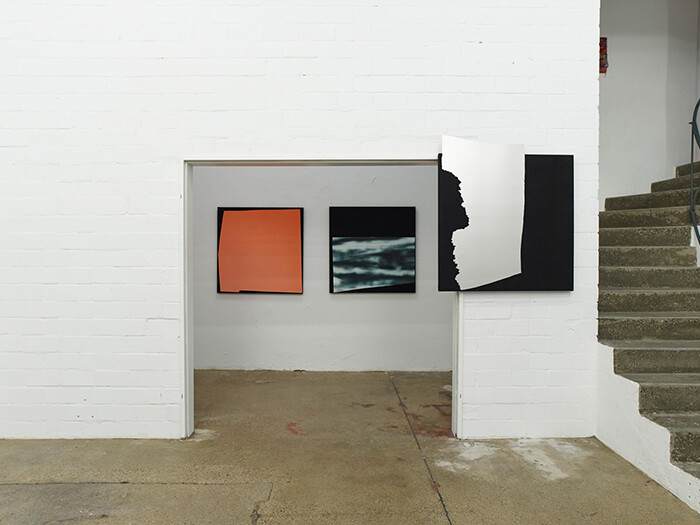Los Angeles has long been pursuing the economies of pink, but it has been pursuing a phantom. Pink is a non-existent wavelength of light. We cannot perceive it, but literally imagine it. Its features disclose themselves in every BPA-free bottle of pink coconut water, in Lindsay Lohan’s strawberry blonde tresses starring in The Canyons (2013)—Paul Schrader and Bret Easton Ellis’s “acid-etched horror story” complete with a trailer by Kanye West—or ultimately in every smog-induced sunset spectacle off Santa Monica beach.1 A little bit like Ed Ruscha’s pastel-on-paper work Another Hollywood Dream Bubble Popped (1976), the economies of pink allow the space of representation, not the pictorial space to rule. About that space of representation, Michel Foucault wrote that it transpires “only on the surface, no more than a polished stone, bearing words and shapes: beneath, nothing […] a gravestone.”2
Unsurprisingly, the asymptote of these economies runs along a vital art market. Ruscha’s slick aesthetic, boasting sharp edges and lurid gradients, shaped the idiom of pop by cutting through it with L.A. archetypes. In contrast, it is the gonzo debonair attitude of living and working in a garage in early sixties Venice—established by the artists gathered around Walter Hopps’s and Edward Kienholz’s Ferus gallery—that matters most for the more compelling art practices in Los Angeles today.
Supportico Lopez’s gallerists Stefania Palumbo and Gigiotto del Vecchio spent last July in Venice, following an exchange with L.A.’s Paradise Garage. Liz Craft and Pentti Monkkonen’s quirky off-space served as the backdrop for an exploration of the city’s scene. Back in Berlin, the results are on view in their current show “The Word Today Serves No One Except To Say To The Grocer Give Me A Pound Of Lentils.” The lengthy title exports one message, at least: no musings about painting; rather, inquiries into the parameters of its possible transformation. Whereas the monetary value of painting has risen exorbitantly over the past few decades, its capacity to disturb the power of the representational has not. A question comes to mind: what would a non-representational painting be today? Philosopher François Laruelle has advocated for the establishment of a non-standard method in philosophy—a method rooted in analytical and anarchic thought, nourishing radical immanence.3 Following this, perhaps we should render this question more keenly: in what ways might painting transgress the colossal status of the image and make us think painting rather than think about painting?
The show at Supportico Lopez offers a few suggestions. A triptych at the entrance draws together Kim Fisher’s Aluminum #10 (Vertical Tear), Magazine Painting (Faded Coral Pink), and Magazine Painting (Night Ocean) (all 2014) and is the optical herald of the show. Fisher’s technique is collage, helping her to tiptoe around painting. The oil-on-linen works mimic L.A.’s visualities. Observed from afar, they seem like atmospheric extractions from a drive on Pacific Coast Highway. Next to Fisher, two works by Channing Hansen—CMBR (2013) and Untitled (Grid Horizon) (2014)—continue to vary the spin on painting. While delicately offhand in their formal appearance, the knitted panels are based on a predetermined algorithm Hansen follows during manual fabrication. The conjoined labor of the manufacturer and the algorithm, the interweaving of hand-dyed natural fabrics and high-tech polymer threads, the visible framing and the multidimensionality of perspectives that Hansen attempts to open leave homespun aesthetics far behind. Although petite in comparison, the works on view are an ode to the creations of the Jacquard loom, its complexity and innovation a flint behind intricate loop structures.
David Korty’s Blue Shelf #25 (2014) occupies the center of a smaller room. By leaving out horizontal partitioning, this—an almost sculptural collage—annuls the driving principle of the Blue Shelf series. It might just be Korty’s most accomplished piece yet. The amalgam of geometrical forms, lines, watercolor abstractions, the lips of Isabella Rossellini’s Dorothy Vallens, and misspelled anarchy slogans amount to a proficient recall of concrete poetry. It is fitting that two untitled pencil-and-ink-on-paper pieces (both 1952) from Shozo Shimamoto—a Japanese pioneer of mail art—are placed just next to it. Its tiny, but fervently whirling arrows literally suck us further into the larger room.
There, Supportico Lopez’s cast of all-star collaborators takes over with over a dozen additional works, leaving us puzzled as to why L.A.’s novel art practices are thrown overboard after such a strong overture. However, a decisive pull comes from Zin Taylor’s Alphabet City (2013) and its eight MDF boards covered with paint and ink. The giant, black-and-white fold-outs seem to be mapping auguries by storytellers from unknown semantic zones. It whispers to us in pidgin. Such vernacular language brings a promise: an escape route from the pinkification of surfaces and into non-representational painting.
Film critic Kent Jones as quoted in the trailer of The Canyons.
Michel Foucault, This is not a Pipe (Berkeley: University of California Press, 1983), 41.
François Laruelle, “A Summary of Non-Philosophy,” Pli. The Warwick Journal of Philosophy, vol. 8. (Coventry: University of Warwick Press, 1999), 138–148.









